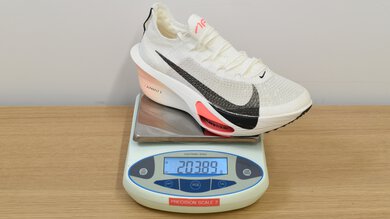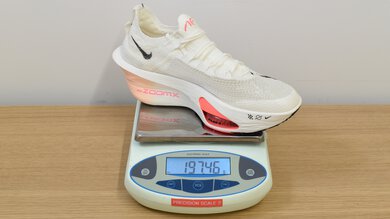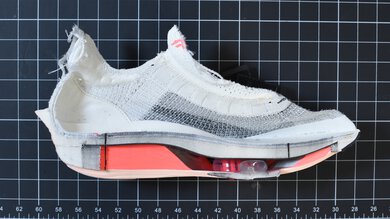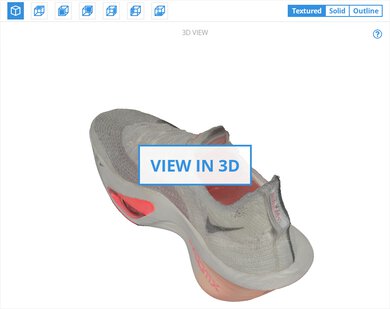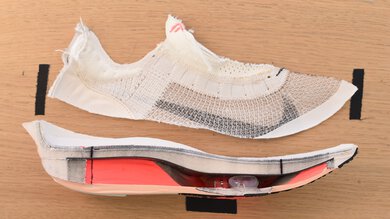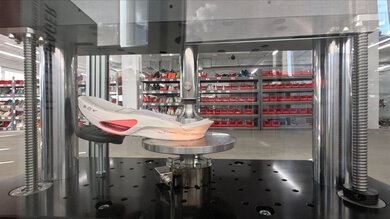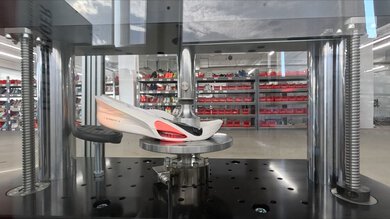The Nike Alphafly 3 is a marathon super shoe designed for those aiming to push their limits on race day, blending high-tech innovation with marathon-focused comfort. Featuring a lightweight meshy upper and a redesigned midsole with ZoomX, Nike's premium PEBA foam, for a smoother stride, this shoe promises an efficient experience in any race but particularly excels in maintaining energy return and comfort all the way through the 26.2 miles of a marathon. With a refined carbon-fiber plate and repositioned forefoot Air Pods, the Alphafly is back to deliver the signature energetic ride that originally defined it.
Our Verdict
The Nike Alphafly 3 is a record-setting super shoe designed for marathon runners, offering a lightweight build, a carbon plate, and great energy return, which are crucial for maintaining an efficient stride over long distances. Its ZoomX foam provides a good balance between comfort and responsiveness, making it well-suited for endurance events.
The ZoomX foam delivers impressive energy return.
Very lightweight.
Good cushioning helps in impact absorption.
Good stability for a super shoe.
Not the most stable shoe in general.
The Nike Alphafly 3 performs well for shorter-distance racing since it offers great energy return. It's also lightweight and has a carbon plate, which is ideal for shorter races. However, the forefoot isn't the firmness, so it doesn't feel extra snappy at faster paces.
The ZoomX foam delivers impressive energy return.
Very lightweight.
Not the most snappy option for shorter events.
Thanks to its premium PEBA foam, the Nike Alphafly 3 efficiently returns the energy you exert with each step. This delivers its signature bouncy feel and helps you maintain efficiency throughout your stride, especially during longer efforts.
The ZoomX foam delivers impressive energy return.
The Nike Alphafly 3's cushioning is very good. The heel cushioning provides a good level of comfort, effectively absorbing impact, while the forefoot is even more cushioned, likely due to the Air Pods that are designed to absorb a lot of energy.
Good cushioning helps in impact absorption.
Like most super shoes, the Nike Alphafly 3's design prioritizes optimal performance, which often comes at the cost of stability. This tradeoff is mainly due to its high stack height, which places the foot further from the ground, and the relatively soft heel. That said, this model has good stability for a super shoe, though runners who need extra support may find it lacking.
Good stability for a super shoe.
Not the most stable shoe in general.
Performance Usages
Changelog
-
Updated Oct 23, 2025:
We updated the review to include text for the Forefoot Long Run Cushioning test, which was recently added to our test bench.
- Updated Oct 23, 2025: We've converted this review to Test Bench 0.9, which adds a Forefoot Long Run Cushioning test to our performance section. Read more in our changelog.
-
Updated Oct 01, 2025:
We updated the Cushioning, 5K/10K, Heel Cushioning, and Forefoot Firmness boxes to align with the latest test bench, refreshed the Popular Running Shoe Comparisons section, and revised the side-by-side comparisons to keep the review accurate.
- Updated Oct 01, 2025: We've converted this review to Test Bench 0.8.2, which updates our methodology for the impact force range used in our compression tests to improve their accuracy. This also affects all usage and performance usage boxes using those compression tests as score components.
Check Price
Differences Between Sizes And Variants
We tested the Nike Alphafly 3 in men's US size 9, as indicated on the label. The color shown here is Sail/Crimson Tint/Guava Ice/Black. This model is also available in other colorways, including Volt/Dusty Cactus/Total Orange/Concord and White/Purple Agate/Vivid Grape/Black, as well as special versions like the Electric edition, the Blueprint edition, and the "Eliud Kipchoge" edition.
Wide versions aren't available for this shoe.
Popular Running Shoe Comparisons
The Nike Alphafly 3 distinguishes itself from daily trainers and super trainers with its impressive energy return, making it a great option for long-distance racing, particularly marathons. Designed to maximize efficiency at sustained speeds, it's a pure racing tool rather than a multi-purpose running shoe.
Most running shoes we've tested offer more stability than this one, including some other super shoes like the Saucony Endorphin Pro 4. However, it remains quite stable within its category, more so than the Nike Vaporfly 4, due to its wider base. The Vaporfly 4 is lighter and stiffer, making it a preferred choice for shorter events up to 10K runs. In contrast, the Nike Alphafly 3 offers a superior balance of cushioning and performance, making it a standout choice for longer distances. Overall, this is one of the best pure marathon racers available, excelling in energy return and efficiency for long-distance racing. If you're looking for a carbon-plated super trainer optimized for hard interval sessions, check out the Nike Zoom Fly 6.
If you're looking for more shoes from Nike's lineup, take a look at our recommendations for the best Nike running shoes. For more options, check out our recommendations for the best running shoes to find the perfect pair.
The adidas Adizero Adios Pro 4 and Nike Alphafly 3 are both elite-level racing shoes built for long-distance performance, but they deliver distinctly different experiences. The adidas shoe offers slightly better energy return and more cushioning, making it especially well-suited for marathon racing. The Nike shoe, while also a strong long-distance option, has a firmer forefoot, thanks to its Zoom Air pods, which give it the edge for shorter events like 5Ks or 10Ks. It's also more stable laterally, offering a bit more confidence.
The Nike Vaporfly 3 and the Nike Alphafly 3 are two premium racing shoes, each catering to different types of runners and race distances, and your choice will depend on your priorities. The Vaporfly 3 is lighter and more agile and provides a firmer ride, making it a strong choice for shorter-distance races up to the half-marathon. It also has a lower stack height. However, the Alphafly 3 has somewhat better lateral stability, making it better suited for marathon racing. It's more cushioned, which can help absorb impact, especially in the later miles of a race. While the Vaporfly 3 is more snappy for shorter distances, the Alphafly 3 is designed to optimize efficiency over 26.2 miles, making it the preferred option for marathon specialists.
The Nike Zoom Fly 6 and the Nike Alphafly 3 share visual similarities and core components, but they serve very different purposes. The Alphafly 3 is Nike's flagship marathon racer, built for maximum efficiency and propulsion with Zoom Air pods, a full ZoomX midsole, and a lighter overall weight. It’s designed to feel explosive and energetic at race pace, offering a uniquely spring-loaded forefoot that shines in long-distance racing. In contrast, the Zoom Fly 6 is a more accessible, training-focused take on that formula, featuring only a thin top layer of ZoomX over a firmer SR-02 carrier foam, resulting in a more muted and less responsive ride. It's also noticeably heavier and better suited for steady long runs or marathon-pace workouts. While the Alphafly 3 feels refined and race-ready, the Zoom Fly 6 is more durable and a safer introduction to plated shoes, especially for runners not yet ready to jump into a super shoe racer. That said, the gap in performance is significant—if you're chasing personal bests on race day, the Alphafly 3 is in a different class altogether.
The Nike Alphafly 3 and the ASICS METASPEED SKY PARIS are both top-tier super shoes, but they deliver very different sensations underfoot. The Alphafly 3 is heavier, but it offers a bit more overall cushioning, making it a better option for runners who value long-distance protection and impact absorption. That said, it still features some firmness in the forefoot, thanks to its distinctive Air Pods. In contrast, the ASICS is lighter, with a more direct and snappy ride that favors runners who prefer ground contact and sharp transitions, making it more specialized for shorter races.
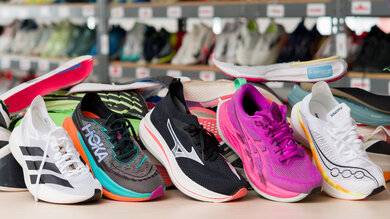
We've recently started buying and testing running shoes with a very data-oriented approach. While we're just getting started, our methodology already has dozens of tests to help you make the right purchasing decision for your needs. Not only do we use high-end equipment to gather objective data, but we also order multiple sizes of the same shoes for team members to be able to log in miles. This real-world testing is done at various paces and conditions, and with different types of workouts, to cover all the bases. This allows us to verify our results and ensure they align with what you might feel with a specific pair.
Test Results

This shoe is impressively lightweight. As a super shoe, it's already very light, which is crucial for optimal performance in race conditions. Even within its category, it stands on par or lighter than most other super shoes, except for the adidas Adizero Adios Pro Evo 1, which is significantly lighter. More importantly, it's considerably lighter than the Nike Alphafly 2, making it more agile overall.
This super shoe delivers great energy return. In the heel, this means the shoe's ZoomX foam efficiently channels the energy you exert with each step. This can be particularly beneficial over long distances, as it helps counteract the effects of fatigue, allowing you to sustain momentum even when your form starts to break down.
The forefoot delivers even greater energy return as the foam compresses and rebounds effectively under pressure, providing that signature bouncy feel that helps propel you forward during runs. This enhances responsiveness and helps maintain efficiency throughout the entire stride.
The heel cushioning provides a good level of energy absorption, ensuring a forgiving landing with each stride. This feature is especially beneficial for runners prioritizing comfort and impact protection during long-distance runs or when striking heavily on their heels. However, very powerful runners will find it comparatively less cushioned than runners who apply less force when striking.
These shoes offer a decent level of energy absorption at the forefoot, providing a moderately cushioned feel underfoot. If you want superior underfoot protection, check out the adidas Adizero Adios Pro 4.
This shoe's heel stiffness is very low, which aligns with its design as a performance-focused shoe for long-distance running. This flexibility helps reduce strain on the legs, particularly during the final miles of a marathon. While this may slightly compromise stability, it's a typical trade-off for super shoes to optimize speed and performance. Also, other super shoes, such as the Mizuno Wave Rebellion Pro 3, are even softer.
The Nike Alphafly 3 is quite stiff, providing a stable platform for energy transfer during toe-offs. However, it's not as stiff as its cousin, the Nike Vaporfly 4, which is better suited for shorter-distance races. This makes this model ideal for long-distance running, where some balance is beneficial for sustained comfort and performance.
The Nike Alphafly 3 delivers very good long-run cushioning thanks to its ZoomX foam and forefoot Air Pod, which together provide a reliable and protective ride. What stands out most is how consistent the cushioning remains throughout a marathon. Runners will feel it's almost as cushioned and plush at the finish line as at the start, making it a durable and reliable option for long-distance racing.

